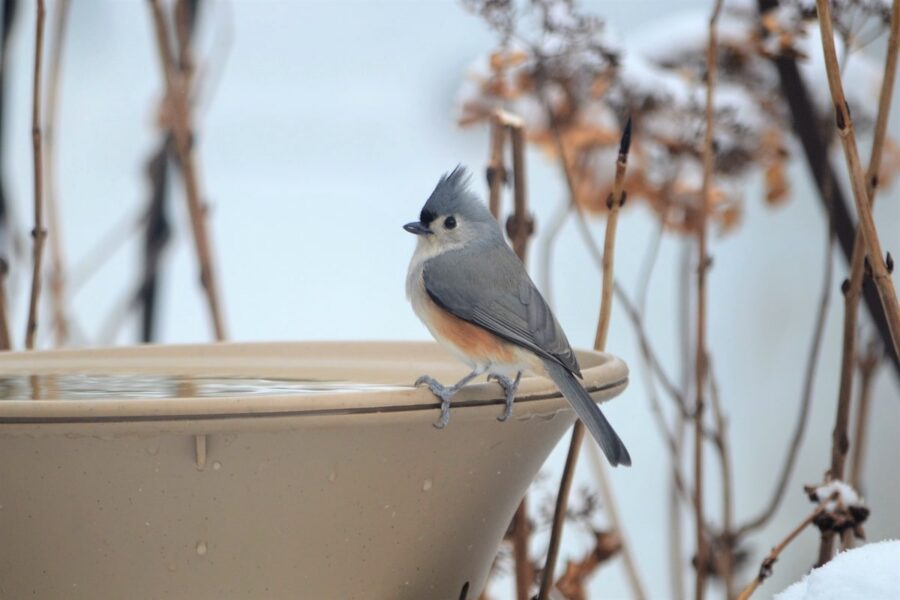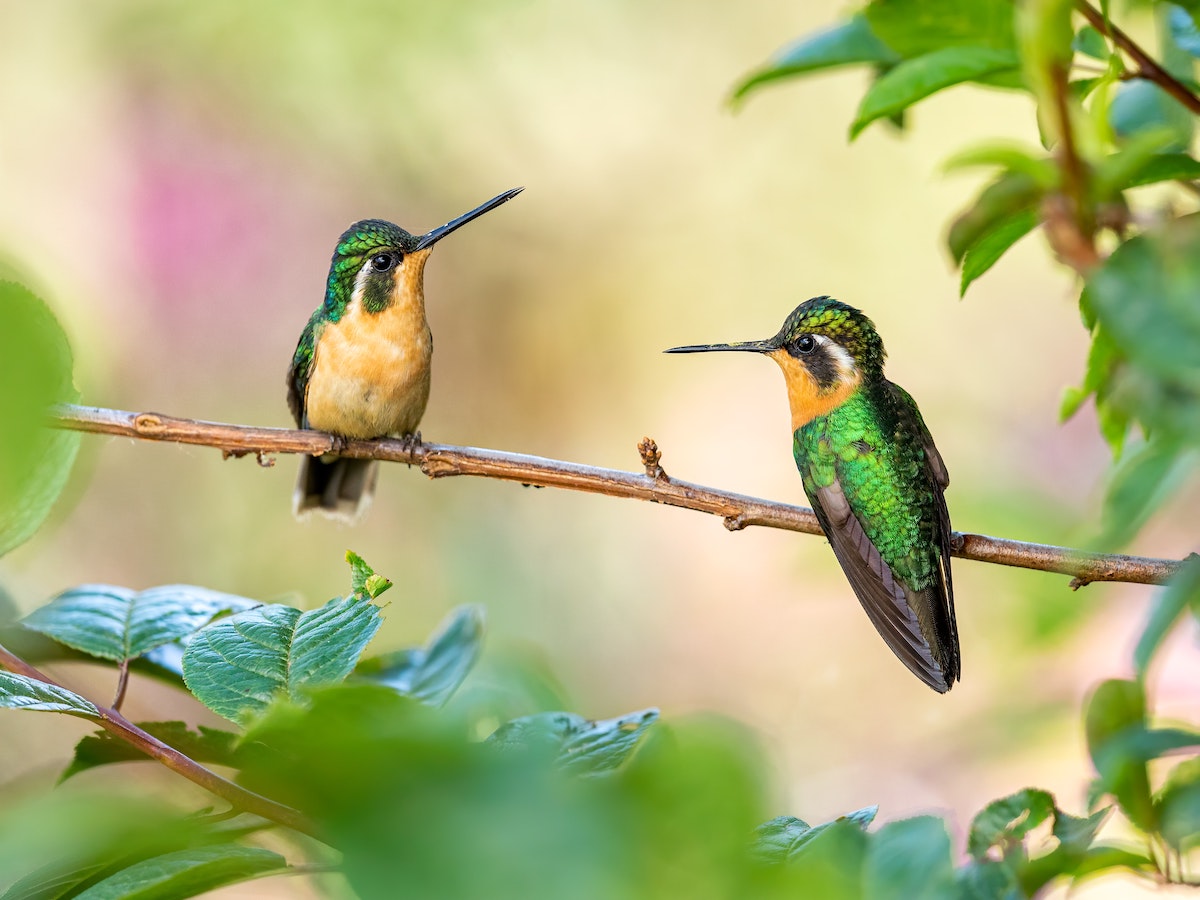Most bird lovers want hummingbirds to visit them at home. You probably do not need an explanation why! These thumb-sized gems are as fascinating as they are gorgeous. If your garden needs more hummingbirds or you are yet to see the first one visit your feeding station, then our list of suggestions will show you several effective ways to invite these sparkly birds over for regular visits!
Table of Contents
1. Provide Fresh Water
Let’s start with the most basic need of all birds and that is water. Most novice birdwatchers believe that nectar is enough to hydrate a hummingbird but this is a myth. Sometimes, when these birds visit a garden, it is not because of the feeding station but because they know that there is a constant supply of fresh water.
2. Use The Correct Nectar Recipe
The good news is that the recipe is very simple! According to the Smithsonian’s National Zoo, you only need water and refined white sugar for the perfect hummingbird nectar recipe. You should never add red dye to the mix (a popular practice). This can actually harm the birds.
Mix 1 part sugar in 4 parts water. Make sure that the sugar is completely dissolved. Place inside the feeder and hang outside. It is important to change the nectar every second day and also to thoroughly clean the feeder when you do. When nectar is left standing or the feeder is not properly maintained, mold can take hold and also threaten the health of the birds.
3. Offer Natural Feeding Choices (AKA Flowers)
If you love hummingbirds, then the chances are that you also enjoy a beautiful garden. So why not add a few extra flowering plants to your property? It will add more grace to your garden and also attract more feathery guests! A hummingbird will adore any flower with sap but let’s look at the best blooms that are known to attract these birds.
- Petunia.
- Bleeding hearts.
- Zinnia.
- Trumpet creeper.
- Bee balm.
- Cupine.
- Salvia.
- Cardinal flower.
- Butterfly bush.
- Columbine.
4. Deadhead Your Flowers

Deadheading is when you remove flowers that are old or dead. It also sometimes involves the removal of seedheads. This often encourages the plant to produce more flowers and seedheads. This is ideal if you want lots of seeds for next year and also plenty of nectar for your hummingbird friends.
5. Ant-Proof Feeding Stations
Nobody likes an ant up their nose – or beak. Unfortunately, ants are super attracted to sweet stuff and that includes the hummingbird nectar recipe that you served this morning. The bad news is that hummingbirds will quickly avoid gardens where the feeding stations are crawling with ants.
The best solutions include a homemade water moat or purchasing a feeding station that is specifically designed to deter ants. Never use insecticide around the feeder to control pests as this can poison the birds.
6. Use Red And Orange Signs
Many salted birdwatchers swear by this tip. Apparently, hummingbirds are attracted to bright red and orange. This tip might just be the thing you need if no hummingbird has ever visited your garden before. You can “advertise” to hummingbirds that your property is a great place by adding color where you can.
Let’s look at a few suggestions! You can plant more red or orange flowers or string red or orange tape around posts and trees. Get creative and paint flower pots red, use red feeders and tie orange ribbons on branches.
7. Provide Perches
Hummingbirds spend an enormous amount of energy when they fly. That’s why their wing beats are pretty much a blur to the human eye! While they do spend most of their time in the air, these tiny birds will appreciate a place to rest. Provide perches for them around the garden. A great place to add a few perches is near the feeding station.
8. Install A Birdbath

Hey, if you already have a birdbath in your garden then you are all set. In case you don’t, why not consider one? It will attract several species of birds, which is a sign to hummingbirds that the garden is a safe place to visit. Hummingbirds also love to bathe, so adding this luxury near their feeding station is sure to earn you a few fans!
9. Add Several Feeders To Your Garden
Hummingbirds may appear to be the darlings of the bird world. But here’s a fair warning. They will compete for a good food source. Very often, one bird will drive others away so that he or she can “own” the feeder. Needless to say, this will reduce the number of hummingbirds that visit your garden.
Adding several feeders to your property is more work, nectar and maintenance wise. But the rewards will be worth it. Plenty of these living jewels will hover around your garden on a daily basis. You know, without fighting each other!
10. Leave The Spiders Alone
This is perhaps the last thing you want to hear – especially if you get the creeps every time you see a spider. But here is the thing. Hummingbirds use spiderwebs as one of the main building materials for their nests.
If they notice these precious strings in your garden – and the feeding stations – then they will almost certainly nest on your property or nearby. When hummingbirds choose an area near your home to raise a family, that’s awesome because you are then more likely to see them every day.
11. Choose The Feeder’s Location Wisely
When you hang a feeder in a place where neither you nor the hummingbird can get a good view, the results might be poor. The birds won’t know that there’s a new food source and you might struggle to see them feed on the off chance that they discover the station. Hang a new feeder near a bush where these birds are already feeding or out in the open to attract your first hummingbirds. Choose a location where there is safety, water, perches and a clear view for you!
12. Keep Bees At Bay

Hey, we all love bees and we know how important they are to the environment. But at a feeding station, they pose a real danger to hummingbirds. To prevent bees from loving your station, make sure that the device does not leak. But at the end of the day, the best option is to buy a hummingbird feeder that is specifically designed to attract these birds without drawing the attention of bees.
13. Provide Nectar For As Long As Possible
Some hummingbird species are migratory. They tend to arrive in most places in early spring and leave when fall is around the corner. Always hang your feeders up early to catch the first hummingbirds as they arrive and don’t be too quick to take the stations down during the fall. There are always a few stragglers and they will appreciate a good drink of nectar before they migrate.
14. Get Your Neighbors Involved
If your neighbors also love birds, encourage them to hang up hummingbird feeders. Why? To attract birds to your own garden, you also want the surrounding areas to be as attractive as possible to hummingbirds.
15. Take A Few Deep Breaths
In other words, be patient! If hummingbirds have never visited your garden before, be aware that it’s totally normal for weeks or months to pass before hummingbirds discover the paradise you have created for them. Too many people lose heart after a few days go by without any sightings. If you live in an area where hummingbirds is a native species, then keep practising these tips. They will come.
FAQ

Hummingbirds do not exclusively subsist on a diet of flower nectar. They also feed on insects. However, feeding on flowers is a big part of their eating habits and a hummingbird consumes up to 12 times their own body weight in nectar every day.
No. Hummingbirds can fly exceptionally well but their feet and legs are basic. These birds use their feet to grip a perch or nest and can shuffle at best.
There are more than 330 species of hummingbirds. One of the most common species is the Ruby-Throated Hummingbird which is regularly sighted in gardens.
By many standards, these birds have a short lifespan. Their life expectancy is between 3 and 5 years. Most die within the first year.

